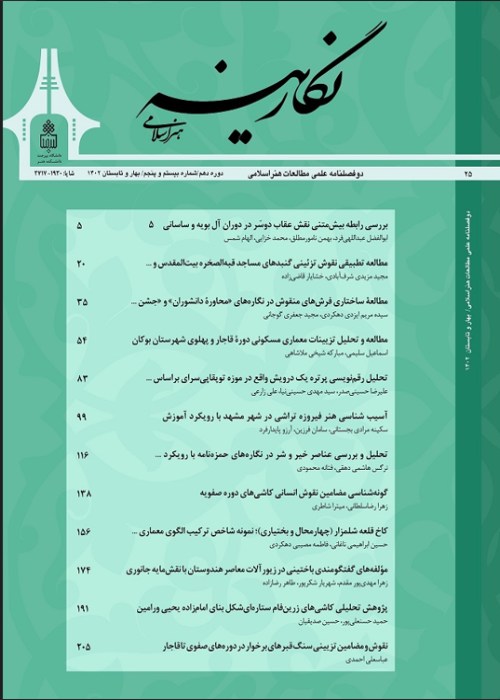A comparative study of the relationship between text and imageIn the picture of the Ascension of the Holy Prophet from Tahmasebi's Khamseh and Jami's Haft Awrang.
Written works left by their predecessors constitute the civilizational, intellectual and cultural heritage of a nation. Meanwhile, language and literature are also an important part of the written heritage that transmits the thought and art of the past to contemporaries. This literature has been manifested in many periods of narrative mode in the form of drawing and visual expression. This practice not only informs us of the richness of the literature of each period, but also the images formed on the basis of the same literature inform us of the community, mystical, philosophical, religious and even political views of that valley period. Accordingly, this study seeks to answer these questions in a descriptive-analytical manner and with a comparative approach with a descriptive-analytical approach in order to apply the relationship between text and image and to analyze the differences and commonalities of the image of the Ascension of the Holy Prophet (PBUH) in two illustrated versionsA: What methods and qualities have the painters used for the fidelity of the text and image in the illustration of the painting of the Ascension of the Holy Prophet (PBUH) in two versions, Tahmasebi's Khamseh and Jami's Haft Awrang?B: What are the commonalities and differences between the picture of the Ascension of the Holy Prophet (PBUH) in the two versions of Tahmasebi's Khamseh and Jami's Haft Awrang?The present research has been done in a descriptive-analytical manner with a comparative approach and its data has been collected by searching library resources and observing the works. The statistical population includes a duplicate of the scene of the Ascension of the Holy Prophet (PBUH) from Tahmasebi's Khamseh and the Jami's Haft Awrang, which has been analyzed and applied qualitatively and through deductive reasoning.In the study, the visual features, such as design, color and structure, the details and elements and phenomena in the image and the type of staging, and the general space of the painting have been considered. Although the results show a high degree of effort of court commissioners and painters to be loyal to the poets' poems, but in some details and scenes, interventions and changes and transformations can be seen, which are mainly rooted in the creative efforts of artists and following the style of painting. The rule of the rulers goes back to the luxurious, ornate and eye-catching atmospheres.
- حق عضویت دریافتی صرف حمایت از نشریات عضو و نگهداری، تکمیل و توسعه مگیران میشود.
- پرداخت حق اشتراک و دانلود مقالات اجازه بازنشر آن در سایر رسانههای چاپی و دیجیتال را به کاربر نمیدهد.




